Autumn Gear Guide
Find inspiration in our Gear Guide that will keep you out on your bike through wind or rain.
Download NowWhy buy a cargo bike, types of cargo bikes, how to ride them, and buyer’s guide.
Cargo bikes are transforming the way we move, shop, and live in urban environments, offering eco-friendly and versatile solutions for a variety of needs. Our guide to cargo bikes is your go-to resource for exploring these innovative modes of transportation. We’ll cover the types of cargo bikes, their benefits, choosing the right one, and more. Whether you’re a seasoned enthusiast or new to cargo bikes, join us on this journey to discover how they’re reshaping urban mobility for a greener, healthier future.
Picture this: you have two young kids that you’re picking up at school, one of them is bringing a friend over, the school is 3 miles from your place, the kids have backpacks, and you need to get groceries on the way home. Or maybe this: you work in the trades, you bring tools to work every day, you have to travel a lot between jobs, and you live and work in a hilly area. What do you do?
If you’re anything like most North Americans, you get in your car. Unfortunately, the vast majority of people on this continent either refrain from regular bike commuting, or stop doing so once they have children or get a job that requires travel with cargo because they simply don’t see bike commuting as a feasible option for their specific circumstance. “Great for college students, maybe, but it won’t work for my lifestyle.”
While much of that hesitation is rooted in the prevailing North American attitude that views cars as the best (or only) transportation option, there are many people who would like to commute by bike but simply aren’t aware of their options.
However, as our cities invest more heavily in safe cycling infrastructure, more and more people are beginning to view bicycling as a feasible option for their daily commute. As such, cargo bikes have seen a small surge in popularity, and an even bigger surge in interest as people explore their options for bike commuting with kids, careers, and the general load-bearing responsibilities that accompany adulthood.
To give a gentle nudge in the bike direction, we’ve put together a guide to cargo bikes for North Americans to get your started.
While your trusty old commuter bicycle enables you to replace a car for the majority of trips you’ll take in a day, a cargo bike enables you to step up your game and leave the car at home for basically every local trip. Traveling with kids? Gardening equipment? Tools? Kids, gardening equipment, and tools? No problem, your cargo bike can handle it. While we’ll concede defeat and admit that they can’t hold literally everything, unless you’re carting around 25 ft steel beams, a shipment of livestock, or 250 lbs of live lobsters, you’ll probably be alright with the cargo bike.
Cargo bikes are, in essence, a workhorse that you don’t have to feed. They enable the transportation of many more pounds of goods than you could possibly carry on a regular bicycle, with much more economic and environmental efficiency than get from a car. They’re your family vehicle, your work truck, your moving van, your party bus. They’re everything you would need a car for, but much more affordable, much more sustainable, and much more fun.
Cargo bikes originated in The Netherlands in the early 20 century, and were used by tradesmen to deliver milk, bread, and other goods in the absence of the automobile. By the 1930s, the phenomenon had spread across Scandinavia. In Copenhagen, Denmark, bike messengers called svajeres carted goods all around the city, and nearly every company owned at least one cargo bike to handle their deliveries.
Around the same time in the UK, deliveries were being made by “butcher’s bike,” a light-capacity cargo bike with a rack mounted to the frame over the front wheel. The British trend spread to the US, where Schwinn produced the original American “cycle truck,” which sold over 10,000 units in a year at its peak of popularity during WWII.
While cargo bikes have remained immensely popular for carting everything from kids to couches in parts of Europe, Asia, and Africa, their use waned considerably in North America when mass marketing of the private automobile began in earnest. These days, many North Americans have never even heard of a bicycle with high carrying capacity.
Only with the recent trend towards high-density urbanism have we seen a resurgence of interest in cargo bikes over here. As with the regular bicycle, many of the original cargo bikes designs are essentially the same today as they were in the early 20th century, with a few modern technological upgrades.
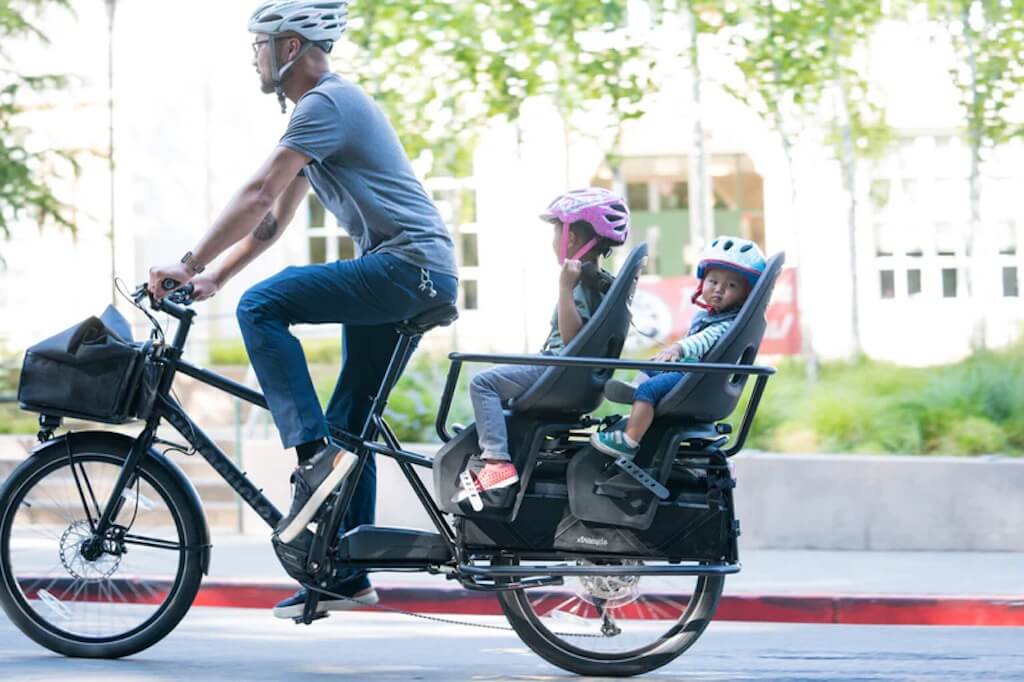
The Xtracycle Stoker
A cargo bike is essentially any bicycle, tricycle or pedal-powered four-wheeler which was designed specifically to carry a load – large or small. In its simplest form, a cargo bike can be a bike with a built-in, reinforced front basket for heavier-than-normal daily transportation needs. In its most complex, it could be an electric-assist box trike with refrigeration capabilities. While these days, the variations of cargo bikes on the market create a bit of crossover between the categories, most cargo bikes fit roughly into the following six types:

Utility bikes are built with a traditional wheelbase, but with reinforced frames that enable them to carry larger loads than a standard bicycle. They often have metal front baskets and/or back racks built onto the frame, and are designed to be nimble and easier to ride than larger cargo bikes while still maintaining considerable carrying capacity.
Johnny Loco, Pashley Cycles, and Worksman Cycles are among the many brands that make utility bikes, which range between $600 and $1,500 USD.
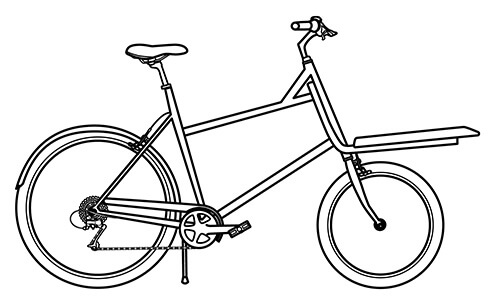
Cycle trucks have the same overall size of a standard city bike, but they have a smaller front wheel (typically 20″ compared to a 26″ rear), with a front rack affixed to the frame over the wheel. The rack either has a box mounted to it, or has mounting options for when you need the box, and space for when you don’t.
Bilenky Cycle Works, Republic Bike, Soma Fabrications, Pashley Cycles, and Bicicapace are among the many brands that make cycle trucks, which range between $700 and $2,000 USD.
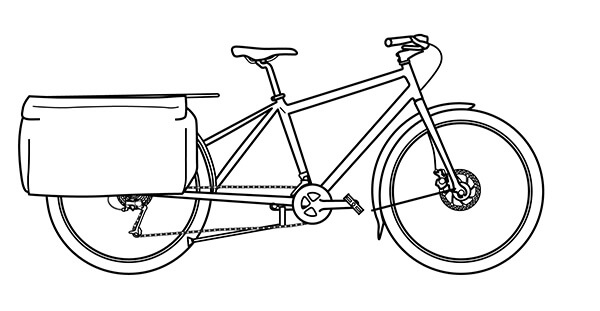
Longtails have an extra-long wheelbase at the back, which accommodates an extended, built-in deck to carry cargo or children. Longtails typically come with open-top panniers to hold cargo at the sides, have hooks for webbing to secure cargo on top, and have options for handles or backrests to transport children.
Yuba, Xtracycle, Tern, Surly, Bike Friday, and Kona Bikes all make longtails, which range up from approximately $1,000USD. Madsen Cycles is notable in that they make a longtail with a box.
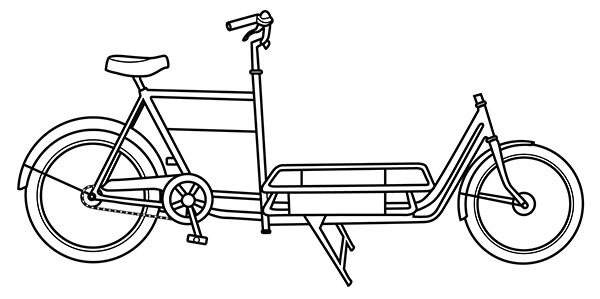
Long Johns were developed in Denmark in the early 20th century. They have an extraordinarily long wheelbase at the front and a smaller front wheel, with the cargo area or an attached wooden basket sitting low to the ground between the handlebars and front wheel. Today, the Long John design has more or less been absorbed into the category of Bakfiets, or Box Bikes, which were developed in The Netherlands in the late 19th century. While Bakfiets were originally a cargo tricycle with a wooden box between the two parallel wheels, modern bakfiets can be either a trike or a two-wheeled Long John design with an integrated box. A few of the brands below make both box bikes and box trikes.
Cetma Cargo, Wike, Fiets of Strength, Larry vs. Harry, Babboe Cargo Bikes, Christiana Bikes, Nihola, trioBike, Douze Cycles, Urban Arrow, and Bakfiets all make box bikes, which range between $2,500 and $6,000 USD.
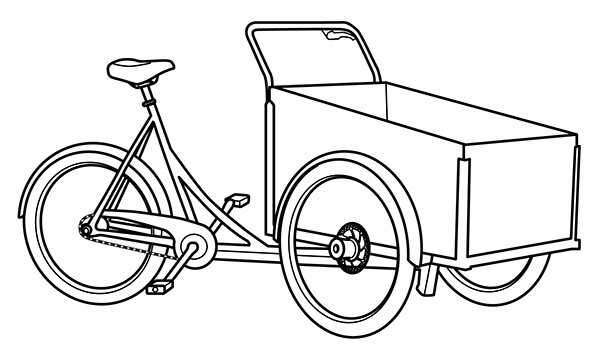
Tricycles or Cycle Rickshaws usually feature an elongated frame with two wheels at the front or back for added stability, with a cargo platform, box, or seat between the two wheels. Cycle rickshaws are common in parts of Asia and Africa as bike taxis, while cargo trikes (often with a box) are common in Europe for personal use, and are becoming increasingly popular in North America.
Wike, Pashley Cycles, Butchers & Bicycles, Johnny Loco, Bakfiets, Boxer Cycles, and Virtue make cargo trikes, which range in price from $3,500 to $5,000 USD. Cycles Maximus is a global manufacturer and distributer of cycle rickshaws, which start off at £3,375.
Above illustrations by Robert Higdon.
When bike commuting enthusiasts point with longing at the well-developed cargo bike culture in The Netherlands, they are often shut down with the all-too-common dismissal, “Easy enough in a small, flat country. But I bike up a hill to get home every day, how is that practical for me?”
And honestly, fair enough. While it’s all very well and good that the cargo bike itself can carry up to 300 lbs of cargo, it’s the rider who will be doing the work to get it to move. Most people are not in good enough shape – or are understandably unwilling – to pedal three kids and a load of groceries straight up a hill every day.
With the recent global boom in e-bikes, cargo bike manufacturers are realizing the potential of electric-assist to make cargo biking viable not just for the super-fit or enthusiast crowd, but for anyone in any geography.
Yuba Bikes, Xtracycle, Pedego Electric Bikes, Radwagon, NTS Works, Felt, Babboe Cargo Bikes, and Douze Cycles make electric cargo bikes, which range in price from $1,700 to $6,000 USD. Johnny Loco makes electric front-loader box bikes and cycle trucks, which begin at $3,000 USD and are available in the US through Seattle E-bike.
While a few people may balk at the hefty price tag of an electric cargo bike, it’s certainly a lot cheaper than owning a car, which is exactly what it’s designed to replace.

Ride one any way you choose! Photo courtesy of Wike.
While there are some well-known names that have dominated the e-cargo bike market over the last few years, since late 2022 everything has changed. Some of the biggest bicycle brands on the planet decided to get into the game releasing decently priced electric cargo bike options as well as other bike brands offering up their own takes on affordable cargo rides. Here are a few of our favourites that have released cargo bikes recently:
Learning to ride a cargo bike varies in difficulty depending on the type, the terrain, and your stature. Longtail cargo bikes are by far the easiest to ride, and loaded up with less than 50 lbs should feel little different than a regular upright bicycle.
For a Long John-style bakfiet or any form of front-loader, you may need to do some work in re-learning how to balance in a straight line, as the extended steering tends to make you overcompensate for small imbalances by sharply turning the front wheel. Keep your eyes on the horizon rather than on the front wheel, and eventually you’ll develop confidence on the bike and balance will no longer be an issue.
With any model of cargo bike, it’s when it’s loaded with cargo that you’ll feel the real difference. Whichever type you go with, the best approach will always be to take your bike for a few rides on quiet streets, empty of cargo. Get a feel for the new width or length, as you’ll have to develop a new sense of spatial awareness for your increased size. Slowly add weight and practice turning, stopping, starting, and riding uphill before you get into traffic.
If you’re a particularly small-statured person, not all models will work for you. Look out for bikes with a low center of gravity such as Bike Fridays, Yubas and some bakfiet models.
When you’re loading up your cargo, keep weight distribution in mind as it will have an impact on the way you ride. Keep heavier items towards the bottom of your box or bags, and do the best you can to evenly distribute weight on either side of the bike. As a general rule no matter your stature, the lower the center of gravity, the easier the bike will be to ride.
There are a few things to consider now that we’ve convinced you to buy a cargo bike, the most important of which is the type of bike itself. While all cargo bikes are good for carrying things, different types have considerably variant benefits depending on what you’re planning to carry and where. A few things to keep in mind:
Use and Infrastructure
Consider what you’re most likely to be carrying around, the kinds of roads you’ll be riding on, and if you expect those needs to change significantly over time. Bakfiets and longtails are great for transporting kids and groceries, but the bakfiets may not be a practical choice unless you have dedicated cycling infrastructure where you’re able to take up space on the road. Trikes are a great option for business as they can be easily retrofitted to suit your particular needs, but depending on the amount of material you expect to be carrying, you may be better off with a simple cycle truck. Take the time to consider the size, shape, and weather-resistance of your expected cargo, and don’t be afraid to ask questions at your bike shop or of other cargo bike commuters before you make your choice.
Storage
Storage is a big one for cargo bikes, which are both heavy and attractive to thieves. Box bikes and trikes cannot be lifted by one person or regularly carried down stairs, so you’ll need a secure, ground-floor storage option to consider those types of bike. When considering any cargo bike, ensure you have an accessible, safe, dry place to store it so it lasts as long as it’s designed to.
Maintenance and Breakdowns
Routine or emergency maintenance isn’t as straightforward with cargo bikes as it is with normal bicycles. Many cargo bikes feature unique steering linkages, long chains or internal hubs that make home care difficult for non-mechanics, and emergency roadside repair nearly impossible. Expect to spend a bit of extra time understanding how your bike works, and a bit more money than usual in maintenance if you’re used to doing your own work. With some cargo bikes, replacing a flat at the roadside can be prohibitively difficult, so have a backup plan such as a phone number for a local hauling agency in case you run into trouble.
Electric Assist
Electric Assist cargo bikes do tend to produce a bit of a shudder when you first see the price tag. But if you live in a hilly area or regularly travel with a lot of gear, the e-assist could be the difference between whether you adopt cargo biking into your regular routine, or relegate the thing to a life collecting dust in the garage as a brief but failed experiment. Once you decide on e-assist, you can look at your options. Some electric cargo bikes only have pedal assist, while others also have a throttle. If you frequently get stopped at a busy intersection halfway up the hill to your house, going the throttle route might be the best way to get what you need out of the upgrade.
Price
Know that you’re going to spend between $1,200 – $6,000 USD. If you budget $3,000 USD for the bike, you’ll have a decent range to choose from and will be able to find something that fits your needs. Budget an additional $250 – $400 USD for rain covers and fenders if you want to equip your bike for rain.
Accessories
Since you paid a pretty penny for the bike, the last thing you want is for it to get stolen. Having a secure lock is a must. A large, flexible lock such as the options from ABUS are a good choice to be able to get around the larger bike. A frame lock as a secondary lock would be a wise investment as well.
Nearly every cargo bike comes with a kickstand, but make sure your choice has a double kickstand or the option to upgrade to one, and get the upgrade. If it’s loaded with a cargo on a single kickstand, you can bet it’s going to fall over.
Availability
Wide distribution of cargo bikes at independent retailers in North America is growing quickly. Gone are the days when only a shop or two around town would carry cargo bikes. Shop around online and see where they are available locally when you’ve narrowed the choice, then get to testing.
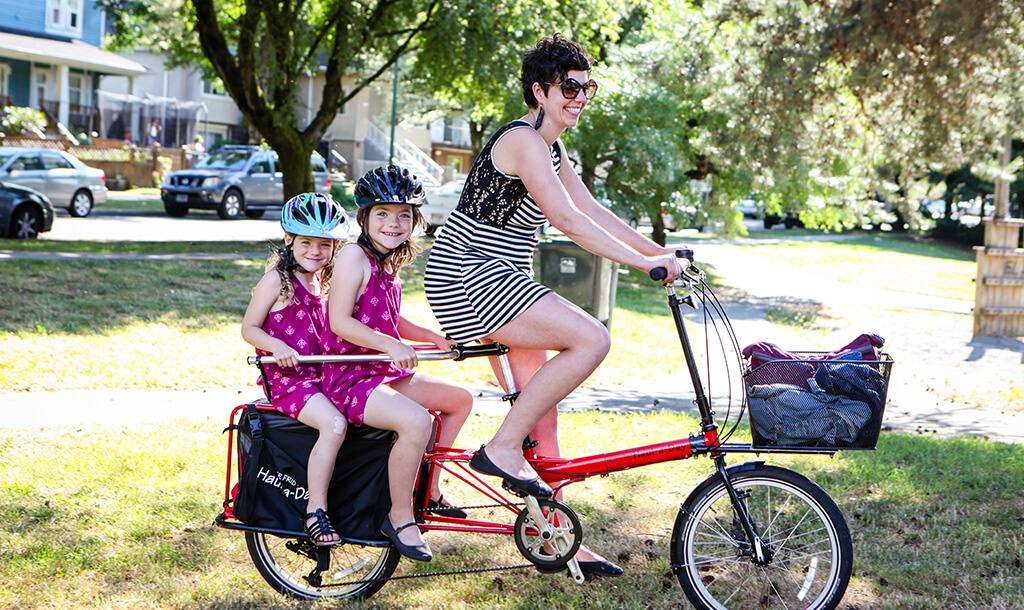
The Bike Friday Haul-a-Day. Photo by David Niddrie.
Find inspiration in our Gear Guide that will keep you out on your bike through wind or rain.
Download Now
Derek Thompson, check out Nihola flex: http://www.nihola.com/products/flex.html
I have a friend of mine who would love to cycle but he has one problem he is in a wheelchair and has little use of his legs as he is only about 5 foot 4 I was wondering if a Butchers Cargo Bike or a Bike Rickshaw type would be suitable
What I need is a bike without a front wheel replaced with a stand or platform the wheelchair would be attached to and I am prepared to push him along all for the fun of being in the open air and in the sun……….There is a pedal assist (electric motor)
bike/wheelchair combination on the market for the ridiculous price of US$18.000.00 (a car does not cost that much) Any suggestions anyone, please (nothing is TOO way out maybe just not practical)
Don’t forget the Argo cargo bike! The ARGO is a conversion kit, that can turn your existing bike into a Long John cargo bike, and back again! Check out https://argobikes.com/ and their Facebook page: https://www.facebook.com/ArgoCargoBikes/
Can you add to the European producer list REcycle?
Enjoy $100 off add-ons for @YubaBicycles #cargobikes with code: AFBOBXBIKE #whatabikecando #cargobikelifestyle #cargobike
you forgot Rodford Built too…..UK http://www.rodfordbuilt.co.uk rodfordbuilt on instagram
Very good information, Tank you. You just forget a cargo company based in Quebec, Canada. It is velo YA http://www.veloya.ca
Don’t forget that children can carry their parents as well.
http://youtu.be/11lmekWEuMg
Hi, we are enjoying our rides with our two grils on the Babboe bike. We love it every single ride. In your summary above you state that Babboe is not sold in North America but only Europe, but at Myamsterdambike webpage they are offering this bike also in the USA. Regarding the business case question of renting cargobikes, I believe an excellent idea. I know that in Europe more people start renting bikes to go around town of Segways (electrical vehicle on two wheels). But we always skip it because we have two kids. Renting a cargobike is great. I believe they have started renting cargobikes as well. Try to find them via internet and connect to discuss the business case. And maybe a brand is willing to provide you discounted bikes for some promotion of the brand. Good luck!
http://www.myamsterdambike.com has a cool deal that every referrer gets $100 refund, unlimited up to a free bike!
I have a project I am thinking of trying to do- Getting Bakfiets rentals and loans into a downtown area- i.e. have people park peripheral to the centre and then get on a trike and shop in the town and then go back to the periphery. I have ridden a reverse trike for a dozen years, they work fantastic all winter- safer than walking. And I can’t walk well as I have MS. So I learned how useful they are. ( Just di newspaper delivery today in Vernon BC- 3 inches of snow , no problem) Anyone have any ideas or thoughts how to bring a program like this about? Funding… partnering..? “trikes in downtown vernon” FB page
I love my Stretch. I’m so glad it came out when I was in the market for an electric cargo bike. It definitely could use some aftermarket kid-hauling accessories, but the overall utility was the best I found of all the bikes I checked out.
Hard to believe you left out the Pedego Stretch Electric Cargo Bike. With dealers in the US and Canada, this may be one of the most available e-bikes to readers of your magazine…not to mention one of the most cost-effective and easiest to get started with. I had someone from a shop that does not carry Pedegos tell me just yesterday that they were envious of the Stretch — he said he considered it one of the best cargo bikes for the money. It’s easily one of my favorite ebikes.
My family has a Zigo, which is really functional as it converts from a cargo bike to a separate stroller and bike. We’ve been riding it with our daughter since she was 6 months. http://www.myzigo.com/
Comments are closed.